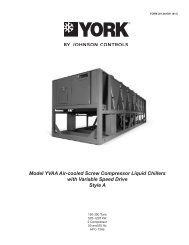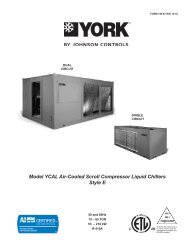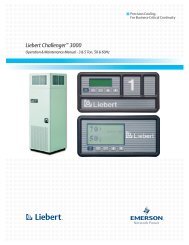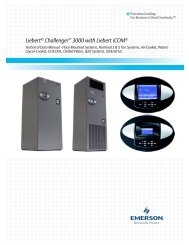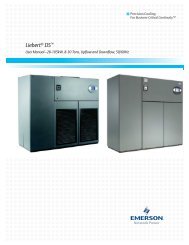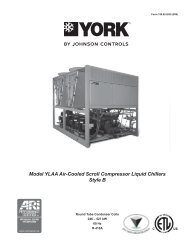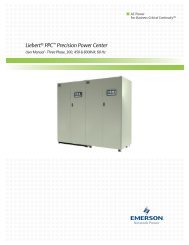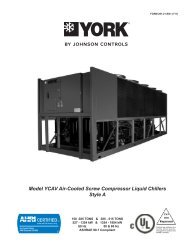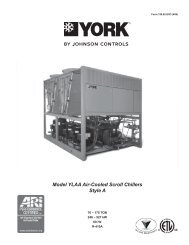Liebert Challenger 3000 with iCOM
Liebert Challenger™ 3000 with iCOM Installation Manual - 3 ... - DCES
Liebert Challenger™ 3000 with iCOM Installation Manual - 3 ... - DCES
- No tags were found...
You also want an ePaper? Increase the reach of your titles
YUMPU automatically turns print PDFs into web optimized ePapers that Google loves.
7.2.2 Low VoltageSplit System ModelsThe control cable between the condensing unit and the evaporator unit is connected betweenterminals 1,2 and 3 on the terminal strip in the evaporator unit and the condensing unit control box.A fourth wire is required on systems <strong>with</strong> hot gas bypass. NEC Class 1 wiring is required. Glycolcooledunits also require a two-wire control connection to the drycooler and pump package.7.3 Piping Considerations7.3.1 Refrigerant LoopNOTICERisk of improper refrigerant charge. Risk of equipment damage, environmental degradationand violation of national, state and local law.Follow all applicable codes for handling refrigerant.R22 and R407C are similar in properties—proper safety equipment and proper refrigerationtools are required on both types. Check unit nameplate for correct refrigerant type beforetopping off or recharging a system.R407C refrigerant must be introduced and charged from the cylinder only as a liquid.NOTICERisk of improper piping installation. Can cause contamination of hygroscopic oil <strong>with</strong> water.When installing field piping, care must be taken to protect all refrigerant lines from theatmosphere, especially when using refrigerants, such as R407C which requires use of polyolester oils. Do not allow the piping to stand open to air for more than 15 minutes. Unitsdesigned for R407C have a compressor that contains polyol ester oil, which is veryhygroscopic; that is, it quickly absorbs water from the air. The longer the compressor piping isleft open to air, the harder it will be to fully evacuate. If left open too long, the polyol ester oilmay need to be replaced before achieving the required vacuum level.NOTEComplete all piping and evacuate lines before connecting quick connects when using anoptional sweat adapter kit and field installed hard piping.Follow all proper brazing practices including a dry nitrogen purge to maintain systemcleanliness.All split systems require two refrigerant lines (an insulated copper suction line and a copper liquidline) between the evaporator and the condensing unit.Two possible methods exist for installing the copper suction and liquid lines.1. Using an optional Sweat Adapter Kit and hard piping between the two units.2. Using optional pre-charged line sets (for 3-ton models only).All refrigeration piping should be installed <strong>with</strong> high temperature brazed joints. Prevailing goodrefrigeration practices should be employed for piping supports, leak testing, evacuation, dehydration,and charging of the refrigeration circuits. The refrigeration piping should be isolated from thebuilding by the use of vibration isolating supports.It is important to handle the pre-charged lines for 3-ton units <strong>with</strong> care so they will not get kinked ordamaged. Use tube benders and make all bends before making connections to either end. Coil anyexcess tubing in a horizontal plane <strong>with</strong> the slope of the tubing toward the condensing unit.To prevent tube damage when sealing openings in walls and to reduce vibration transmission, use asoft flexible material to pack around the tubes.When installing remote condensing units mounted above the evaporator, the suction gas line shouldbe trapped at the evaporator. This trap will retain refrigerant oil in the off cycle. When the unitstarts, oil in the trap is carried up the vertical riser and returns to the compressor.57



